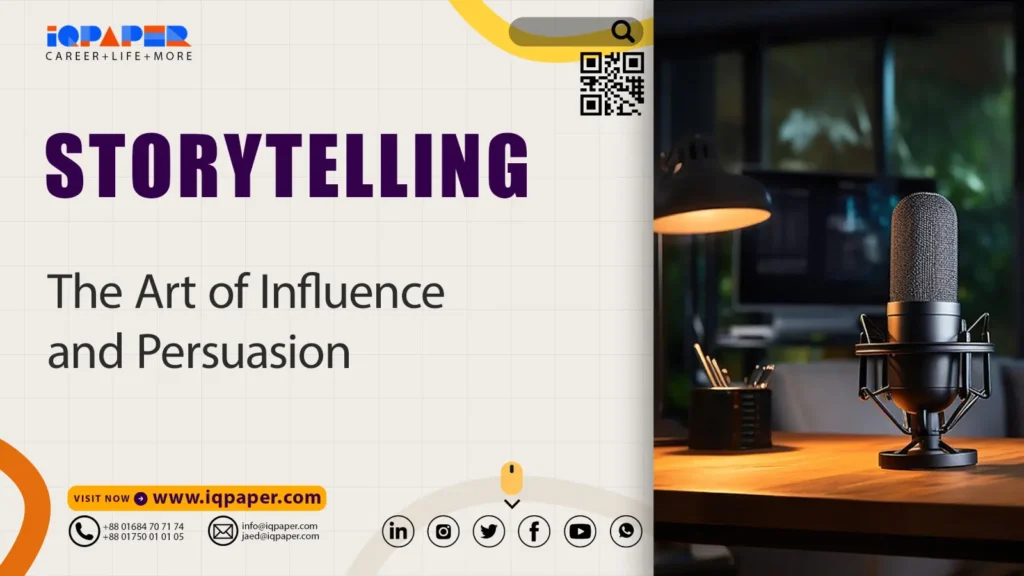In today’s world, storytelling is more than just a way to entertain—it’s a powerful strategy to influence, inspire, and persuade. Whether you’re a leader, marketer, entrepreneur, or teacher, learning how to tell a compelling story can significantly improve how your message is received and remembered.
Stories are not just tales—they are emotional bridges. They reach beyond logic and data to establish a connection that facts alone cannot. If you want to make an impact, tell a story. It’s that simple.
Why Storytelling Matters
🔗 Builds Emotional Connection
A good story resonates with emotions, helping your audience relate and connect with your message on a deeper level.
🧠 Simplifies Complex Ideas
Well-structured stories break down complicated topics into understandable, relatable narratives.
🚀 Inspires Action
Stories don’t just inform—they move people. They motivate audiences to feel, think, and take action.
🧲 Boosts Memorability
People are far more likely to remember a story than a chart full of statistics. A meaningful narrative can stick in someone’s mind for years.
Elements of a Great Story
👤 Relatable Characters
Your story needs a protagonist your audience can understand or empathize with—someone with dreams, challenges, and growth.
⚔️ Compelling Conflict
Conflict creates tension and momentum. Without a struggle, there is no story. Let your character face obstacles that reflect real-life challenges.
🎬 Strong Beginning
Start the story with a hook—an emotional moment, a bold statement, or a question that pulls the audience in.
🧭 Clear Structure
Every story should have a beginning (the problem), middle (the struggle), and end (the solution). Structure keeps the story flowing.
🎯 Powerful Ending
Wrap up with a meaningful message or unexpected insight. Leave the audience thinking, feeling, or ready to act.
Steps to Becoming a Great Storyteller
1. Know Your Audience
Understand who you’re speaking to—their challenges, values, and goals. Tailor your story to solve a specific pain point they care about.
2. Start with a Hook
Grab attention right away.
Example: “What if one small change could double your productivity?”
3. Make It Personal
Share real experiences that reflect your message. Add sensory details to evoke emotion.
Example: “Early in my career, I failed a major project—but that failure became the turning point in my journey.”
4. Keep It Simple and Clear
Avoid jargon or overcomplicating the plot. Stick to the core message.
Quote: “If you can’t explain it simply, you don’t understand it well enough.” – Albert Einstein
5. Create Emotional Connection
Let your audience feel something—joy, empathy, urgency. Stories from real life make your message relatable and enjoyable.
6. Use a Clear Narrative Arc
Your story should include a conflict, a journey, and a resolution.
Example: “We were losing customers. But with one bold shift in strategy, we increased retention by 40%.”
7. Feel the Story, Don’t Just Tell It
Use expressive language, emotions, metaphors, and visuals to make your story come alive.
8. End with a Call to Action
Guide your audience toward the next step.
Example: “Let’s commit to this change today and shape the future we believe in.”
Popular Storytelling Techniques
🎯 The Hero’s Journey
A protagonist faces challenges, transforms, and overcomes obstacles.
Example: A young entrepreneur turns failure into a thriving business.
👣 The Relatable Struggle
Share a problem your audience identifies with.
Example: Battling imposter syndrome before stepping into leadership.
❓ The “What If” Scenario
Present a bold possibility.
Example: “What if you could reset your life in just 7 days?”
🌀 The Twist Ending
Surprise your audience with an unexpected conclusion.
Example: “In the end, the solution had been with us all along.”
😂 Humor and Surprise
Add lightness or unexpected turns to keep the audience engaged.
Example: A funny mishap during a client meeting that taught a valuable lesson.
Tips for Using Storytelling in Business
✅ Share Real Success Stories
Show how your product or service transformed lives. Use customer testimonials or case studies.
📊 Use Data Storytelling
Turn statistics into stories.
Example: “Instead of saying 10,000 people use your app, say, ‘Meet Sarah, who finally managed her anxiety using our tool—and joined 10,000 others doing the same.’”
🧡 Be Authentic
Share both wins and failures. Authenticity earns trust.
🖼️ Incorporate Visuals
Support your story with photos, infographics, or videos. Visuals enhance impact and memory.
Final Thoughts
Storytelling is more than a communication technique—it’s a leadership skill. It allows you to influence at scale, inspire your audience, and create lasting impressions. In business, education, or personal growth, stories are what people remember and act upon.
The good news? Anyone can become a great storyteller. All it takes is practice, intention, and a willingness to be real.
So next time you speak, don’t just inform—inspire through storytelling.
By watching this video of Steve Jobs you will get a clear concept of storytelling.
Your can read our related articles to develop your skills.

Really enjoying this article!
Really insightful article!